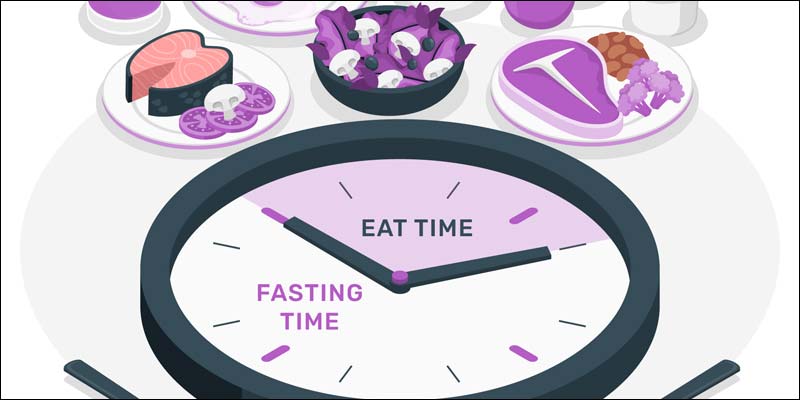In the world of health and wellness, one trend has been making waves for its promising results and transformative effects: Intermittent Fasting (IF). Contrary to traditional dieting methods, IF doesn’t focus on what you eat but rather on when you eat. This approach has garnered attention not only for its weight loss benefits but also for its potential to improve overall health. Let’s delve deeper into what Diet Intermittent Fasting is all about, its various methods, potential health benefits, and how to incorporate it into your lifestyle seamlessly.
Understanding Intermittent Fasting
At its core, intermittent fasting involves cycling between periods of eating and fasting. Unlike conventional diets that dictate specific foods to eat or avoid, IF primarily revolves around when you consume your meals. There are several popular methods of IF, including the 16/8 method, 5:2 diet, and Eat-Stop-Eat. Each of these approaches varies in fasting and eating windows, providing flexibility for individuals to choose what works best for their lifestyle.
How Intermittent Fasting Works
During fasting periods, the body undergoes several metabolic changes that contribute to its health benefits. As the body exhausts its glycogen stores, it shifts to burning fat for fuel, leading to weight loss. Additionally, fasting triggers cellular repair processes enhances hormone function, and may even promote longevity. These mechanisms make intermittent fasting more than just a dieting fad; it’s a lifestyle approach that can positively impact overall well-being.
Health Benefits of Intermittent Fasting
1. Weight Loss and Fat Burning
One of the primary reasons individuals turn to intermittent fasting is its effectiveness in weight management. By creating a calorie deficit during fasting periods, the body taps into stored fat for energy, resulting in fat loss. Studies have shown that IF can be as effective, if not more, than traditional calorie-restricted diets for shedding pounds and reducing body fat percentage.
2. Improved Metabolic Health
Intermittent fasting has been linked to various improvements in metabolic health markers. It can lower insulin levels, reduce inflammation, improve blood sugar control, and enhance insulin sensitivity. These benefits are particularly significant for individuals at risk of type 2 diabetes or those looking to optimize their metabolic function.
3. Enhanced Brain Function
Fasting triggers biochemical changes in the brain that may bolster cognitive function and protect against neurodegenerative diseases. Research suggests that intermittent fasting may increase the production of brain-derived neurotrophic factor (BDNF), a protein that supports the growth and maintenance of neurons. This could potentially reduce the risk of conditions like Alzheimer’s disease and improve overall brain health.
4. Longevity and Cellular Repair
One of the most intriguing aspects of intermittent fasting is its potential to promote longevity and cellular repair. Fasting triggers autophagy, a process where cells remove dysfunctional components and recycle them for energy. By clearing out damaged cellular materials, intermittent fasting may slow down the aging process and reduce the risk of age-related diseases.
Diet Intermittent Fasting
For optimal health benefits, prioritize wholesome foods and drinks during your eating periods.
Opt for nutrient-dense foods to support a balanced diet and maintain a healthy weight. Consider incorporating a variety of whole foods into each meal, such as:
- Fruits: apples, bananas, berries, oranges, peaches, pears, tomatoes, etc.
- Vegetables: broccoli, Brussels sprouts, cauliflower, cucumbers, leafy greens, etc.
- Whole grains: barley, buckwheat, quinoa, rice, oats, etc.
- Healthy fats: olive oil and avocados
- Protein sources: eggs, fish, legumes, meat, poultry, nuts, seeds, etc.
Staying hydrated with calorie-free beverages like water, unsweetened tea, and coffee, even during fasting periods, can help manage your appetite.
It’s advisable to minimize consumption of ultra-processed foods such as packaged snacks, deep-fried items, sugary drinks, and most frozen meals, as these can counteract the benefits of 16/8 intermittent fasting.
Intermittent Fasting Schedule

Several strategies for losing weight include monitoring your food intake, while intermittent fasting (IF) focuses on when you eat. IF involves designated “eating windows” where you can consume meals and fasting periods where you refrain from eating solid foods but can have water, coffee, and tea. The length of these eating and fasting windows varies depending on the specific intermittent fasting schedule you choose to follow.
The 16:8 Diet
The 16:8 intermittent fasting method requires fasting for 16 hours each day and limiting your eating period to eight hours. Typically, this involves abstaining from food after dinner and skipping breakfast, with your eating window falling between, for example, noon and 8 p.m.
The 5:2 Method
With the 5:2 diet, you maintain your regular eating habits for five days a week and reduce your calorie intake to 20 percent of your usual amount for the remaining two days. It’s worth noting that women typically consume around 500 calories on fasting days, while men consume around 600.
Alternate Day Fasting
Named for its pattern, this diet requires fasting on alternate days. Various versions of this plan exist, some permitting approximately 500 calories on fasting days, while others advocate for even fewer or near-zero calorie intake on those days.
Eat Stop Eat Diet
This intermittent fasting approach includes fasting completely for 24 hours once or twice weekly. For instance, you might have dinner at 6 p.m. and then fast until 6 p.m. the following day. This routine is typically repeated once or twice a week, but not consecutively.
The 14:10 Diet
This approach resembles the 16:8 method but with a 14-hour fasting period and a 10-hour eating window. It’s slightly more manageable than 16:8 due to the extended eating window, yet it remains effective for achieving the desired results.
Conclusion
Diet Intermittent fasting offers a holistic approach to health and wellness, focusing on when you eat rather than what you eat. By incorporating fasting periods into your routine, you can unlock a myriad of benefits, including weight loss, improved metabolic health, enhanced brain function, and potentially increased longevity. Whether you’re looking to shed pounds, optimize your health, or simply explore a new lifestyle approach, intermittent fasting holds promise as a sustainable and effective strategy for achieving your goals. So why not give it a try and embark on a journey towards a healthier, happier you?
FAQs
Q1. How much weight can you lose in a month with intermittent fasting?
Remaining consistently active while practicing intermittent fasting can result in a weight loss of up to 6-8 pounds per month. This potential is surprisingly substantial, especially considering that it primarily involves abstaining from eating for specific periods during the day.
Q2. How do I start intermittent fasting?
Beginners embarking on intermittent fasting may discover the 12-hour fasting approach to be the most manageable. This method entails fasting for 12 consecutive hours within a 24-hour cycle. Individuals can incorporate their sleeping hours into this fasting window, such as fasting from 7 p.m. to 7 a.m.
Q3. Can I eat rice during intermittent fasting?
Certainly! While practicing intermittent fasting, it’s permissible to include rice in your diet. However, it’s crucial to eat it only during your designated eating period and in reasonable portions as part of a well-rounded meal.

